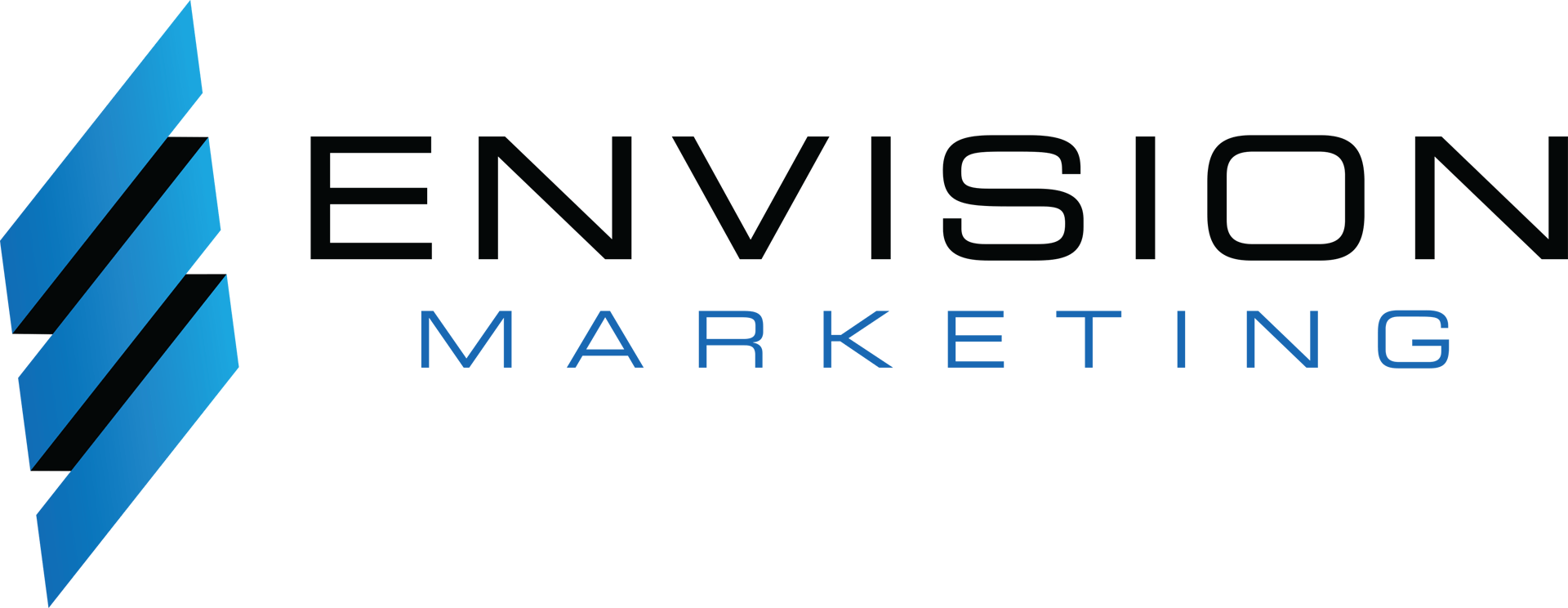Planning for a Successful YouTube Shoot
This is Part 3 of Envision Marketing’s Ultimate Guide to YouTube for Small Local Service Businesses
Cheat Sheet
Here are the most important tips covered in this article
- Account for extra time during shoots: Always allocate more time than you think you need for video shoots.
- Research and create a shot list: Watch similar videos on YouTube and note appealing shots and angles to create a shot list for your own video.
- Prepare your equipment: Optimize your audio and video quality using the equipment you have on hand, focusing on camera selection, stabilization, lighting, and audio.
Proper planning is essential to ensure a smooth and efficient video shoot for your small business YouTube channel. In this part of our comprehensive YouTube guide, we’ll walk you through some essential steps and tips for planning a successful shoot. This will help you stay organized and save time, while producing high-quality content that effectively showcases your business and generates leads.
Account for Extra Time
It’s important to remember that video shoots often take longer than anticipated. Whether it’s setting up equipment, capturing multiple takes, or dealing with unexpected interruptions, it’s wise to build extra time into your schedule. This buffer will help minimize stress and ensure that you have enough time to capture all the necessary footage for your video.
Research and Create a Shot List
Before your shoot, spend some time researching similar videos on YouTube to gather ideas for your own video. Pay attention to the shots and angles that you find most appealing or effective in showcasing the subject or product. Based on your research, create a shot list outlining the specific shots and angles you want to capture during your shoot. This will not only help you stay organized and efficient but also ensure that your video is visually engaging and professional-looking.
Prepare Your Script and Storyboard Thoughtfully
While a script can be useful for some videos, especially promotional ones, there are also advantages to not using a script. Viewers can usually tell when you’re reading from a script, and it may sound less natural. Whatever you decide, some level of preparation is essential to guide your shoot and ensure a coherent flow.
Plan your talking points
If you’re not writing an exact script, try to outline the key points you want to cover in your video. This will help you stay focused while still allowing room for spontaneity and a more natural delivery.
Keep the narration constant
With a few exceptions, it’s crucial to maintain constant narration throughout your video. Viewers are likely to get bored if there’s a lack of dialogue or explanation. Make sure to plan your talking points and prepare to keep the conversation flowing.
Create a storyboard
Even if you’re not using a strict script, it may be helpful to visualize the sequence of shots and scenes. This isn’t necessary for every video; some videos can be created in a single shot. However, a storyboard helps you ensure that your video tells a coherent story and effectively communicates your message. Plan the shots you’d like to include, but be prepared to adjust as needed during the shoot.
By thoughtfully preparing your talking points and storyboard while maintaining flexibility, you’ll create more engaging, authentic videos that resonate with your audience.
Assemble Your Team
Filming a video is often a team effort, especially if your shoot involves multiple people or locations. To keep everyone on the same page, it’s essential to plan and communicate a clear schedule for your shoot. Make sure each team member knows their role and responsibilities, as well as when they are expected to be “on set.” This will help minimize confusion and ensure a more efficient shoot.
Prepare Your Equipment
Having professional equipment isn’t necessary for creating high-quality videos; the content is more important than the production value. However, you can still optimize your audio and video quality with whatever equipment you have available. Here are some tips for selecting and using the right equipment for your video shoot:
Camera
Decide which camera you’ll use, whether it’s a professional camera, smartphone, or webcam (smartphone cameras are plenty good these days!). Ensure you know how to transfer footage from the device to a computer or cloud storage service.
Optional pro-tip: Research the best settings for your camera to maximize quality and convenience. If you can’t find a tutorial, we’re happy to help you optimize your settings.
Stabilization
Determine how you’ll keep your camera steady during the shoot. If you have a tripod or stabilizer, make sure it’s compatible with your camera. If you don’t have one, consider using a stack of books, a table, or other stable surfaces as an improvised stabilizer.
Optional pro-tip: Test your setup before the shoot to ensure it provides steady footage.
Lighting
Plan your lighting setup ahead of time. Identify the light sources you’ll use, such as natural light, lamps, or other available light sources.
Optional pro-tip: Consider using white sheets or sheer curtains to diffuse light, and plan the placement of lights to minimize shadows and create an even distribution of light on your subject.
Audio
Decide which microphone you’ll use for your shoot. If you have a shotgun or studio mic, ensure it’s compatible with your camera or recording device. If you don’t have a separate microphone, that’s fine, but you’ll want to make sure your camera/phone will be close to the subject when capturing audio.
Optional pro-tip: Test the audio quality in your chosen location and make any necessary adjustments, such as adding rugs or blankets to dampen echo.
Optional pro-tip: Prepare a checklist
Create a checklist of all the equipment and materials you’ll need for your shoot, including cameras, microphones, tripods or stabilizers, lighting, and any props or additional items relevant to your content. This will help you ensure you have everything you need on the day of the shoot and avoid any last-minute surprises.
We’ve created a sample checklist at the bottom of this article, which you may use as a starting point.
By carefully considering your equipment and making key decisions ahead of time, you’ll set yourself up for a successful shoot and create high-quality videos without the need for professional equipment.
Plan Your Locations
Many videos can be shot in a single location, or even in front of your computer. However, it’s important to consider the best location(s) for each video. Choose appropriate locations for your shoot that align with the theme and purpose of your video. Consider factors such as lighting, background noise, and visual appeal when selecting your shooting locations.
Optional pro-tip: Scout your locations ahead of time to identify any potential issues or challenges and obtain any necessary permits or permissions.
Consider remote interviews
For some videos, conducting an interview over Zoom or Google Meet can be a suitable option. Remote interviews allow for flexibility and can provide valuable content for your audience. Just ensure you follow the same advice regarding audio, lighting, framing, and background as you would for an in-person shoot.
Consider Props and Wardrobe
While props and wardrobe can enhance your video, they are not a requirement for creating YouTube content. As mentioned in Part 1, use what you have and focus on the value of your content. However, if you feel that certain props or wardrobe items can improve your video, it’s worth considering them. Look for items you already have that can be used as props or wardrobe pieces. There’s no need to invest in expensive or elaborate items when you can use what’s available.
By following these steps and dedicating the necessary time and effort to planning your shoot, you’ll set yourself up for success in creating engaging and effective YouTube content that showcases your business and generates leads.
Pre-Shoot Checklist
Here’s a sample pre-shoot checklist to help you keep track of what needs to be done before your video shoot. Feel free to skip any which feel unnecessary.
- Schedule:
- Allocate ample time for the shoot
- Communicate the schedule to all team members
- Research and Shot List:
- Watch similar videos on YouTube for inspiration
- Create a shot list of appealing shots and angles
- Script and Storyboard:
- Prepare talking points or script
- Create a storyboard, if necessary
- Assemble Your Team:
- Assign roles and responsibilities to each team member
- Confirm each team member’s availability
- Prepare Your Equipment:
- Select a camera and learn how to transfer footage
- Set up stabilization (tripod, stabilizer, or improvised solution)
- Plan lighting (natural light, lamps, etc.) and consider diffusion techniques
- Choose a microphone and test audio quality in the shooting location
- Plan Your Locations:
- Choose the best location(s) for your video, considering lighting, noise, and visual appeal
- Scout locations and obtain necessary permits or permissions, if needed
- Consider remote interviews if applicable
- Props and Wardrobe:
- Identify any necessary props and wardrobe items
- Use what you have and focus on the value of your content



